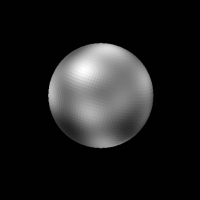Pluto
 |
Origin of name Pluto is named after the Greek god of the underworld.
Discovered by
Naming convention |
Pluto
Once considered to be the ninth planet in the Solar System, Pluto was reclassified as a dwarf planet in 2006.
Physical Properties
| Property | Unit | Value | Earth = 1 |
| Equatorial radius | km | 1195 | 0.187 |
| Polar radius | km | 1195 | 0.180 |
| Flattening | 0.0000 | 0.0 | |
| Mass (x1024) | kg | 0.0125 | 0.0021 |
| Volume (x1010) | km3 | 0.715 | 0.0066 |
| Mean density | kgm-3 | 1750 | 0.317 |
| Surface gravity at equator | ms-2 | 0.58 | 0.059 |
| Escape velocity | kms-1 | 1.2 | 0.107 |
| Number of natural satellites | 3 |
Orbital Parameters
| Property | Unit | Value |
| Perihelion (x106) | km | 4434.99 |
| Aphelion (x106) | km | 7304.33 |
| Mean distance from the Sun (x106) | km | 5900.1 |
| Mean distance from the Sun | AU | 39.44 |
| Eccentricity | 0.2444 | |
| Sidereal orbit period | y | 247.68 |
| Sidereal rotation period | h | R 153.293 |
| Length of day | h | 153.282 |
| Orbit inclination to Ecliptic | ° | 17.16 |
| Mean orbital velocity | kms-1 | 4.72 |
| Maximum orbital velocity | kms-1 | 6.10 |
| Minimum orbital velocity | kms-1 | 3.71 |
| Axial tilt | ° | 122.53 |
Notes
-
Sidereal orbit period
The time taken by the planet to complete exactly one orbit around the Sun with respect to the celestial sphere. -
Sidereal rotation period
The time in which the planet rotates around its axis exactly 360° with respect to the celestial sphere. -
Length of a day
Defined as the time between two successive sunrises over the meridian. -
Magnetic dipole moment
Calculated as the ratio of the magnetic field strength at the equator divided by the cube of the equatorial radius.
Last Update: 1 September 2019
